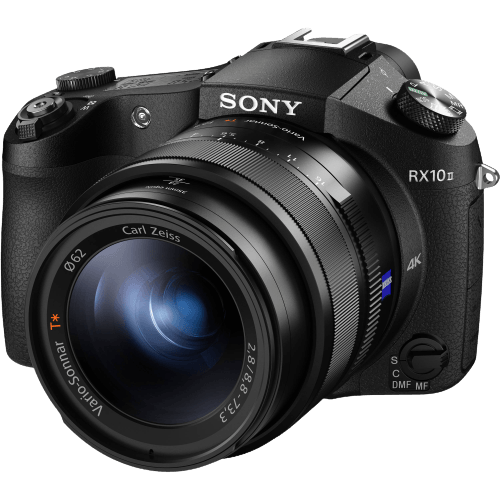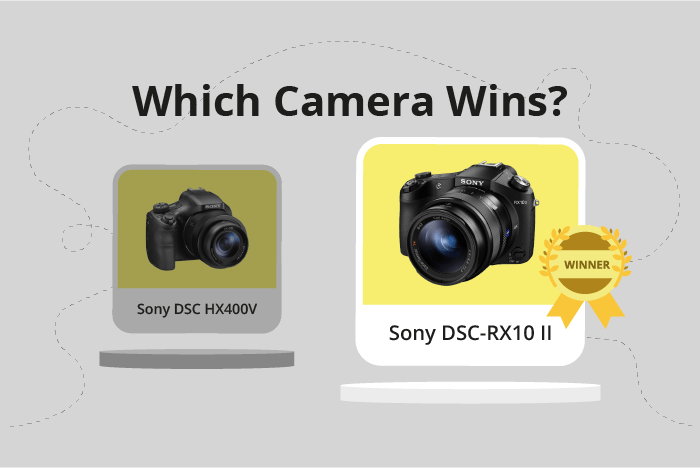Sony Cyber-shot DSC HX400V vs DSC-RX10 II Comparison
Sony Cyber-shot DSC HX400V

Sony Cyber-shot DSC-RX10 II

The Sony Cyber-shot DSC HX400V and the Sony Cyber-shot DSC-RX10 II both received a score of 59/100, making them equal in our evaluation. As bridge cameras, they share several common specifications, such as their announcement years (2014 and 2015, respectively) and similar camera sizes.
However, the HX400V has the advantage of a lower launch price ($499) and a lighter weight (660g / 1.46lbs), making it more affordable and easier to carry. On the other hand, the RX10 II boasts a higher launch price ($1299) but offers no clear advantage in terms of specifications.
Given these points, the HX400V emerges as a more budget-friendly and portable option, while the RX10 II does not present any notable benefits to justify its higher price.
Sony Cyber-shot DSC HX400V vs DSC-RX10 II Overview and Optics
Both the Sony Cyber-shot DSC HX400V and the Sony Cyber-shot DSC-RX10 II have an identical score of 64/100 for their optics. These cameras share several specifications, such as 20-megapixel resolution, a CMOS sensor type, the Bionz X processor, fixed lens mounts, image stabilization, and no lens mount due to the fixed lens design.
The Sony Cyber-shot DSC HX400V has a DXOMARK sensor score of 82, which is higher than the DSC-RX10 II’s score of 70. This means that the HX400V has a better sensor performance. Additionally, the HX400V has an aspect ratio of 4:3, which is more suitable for printing photographs in standard sizes.
On the other hand, the Sony Cyber-shot DSC-RX10 II has a faster shooting speed of 14 frames per second, compared to the HX400V’s 10 frames per second. This allows the RX10 II to capture fast-moving subjects more effectively. The RX10 II also features a larger 1″ sensor size, which contributes to better overall image quality, especially in low-light conditions. Its aspect ratio is 3:2, which is more suited for displaying images on screens.
While both cameras have their strengths and weaknesses, the Sony Cyber-shot DSC HX400V’s higher sensor score and more versatile aspect ratio make it a better choice for those who prioritize image quality and printing. However, the Sony Cyber-shot DSC-RX10 II’s faster shooting speed and larger sensor size make it more suitable for those who need to capture fast-paced action or prefer to display their images digitally.
Sony Cyber-shot DSC HX400V vs DSC-RX10 II Video Performance
The Sony Cyber-shot DSC-RX10 II outperforms the Sony Cyber-shot DSC HX400V in video capabilities, scoring 77 out of 100 compared to the HX400V’s 56. Both cameras share some common specifications, such as lacking built-in time-lapse functionality. However, the RX10 II has several advantages that contribute to its higher score.
The RX10 II offers 4K video resolution, while the HX400V only supports Full HD. This means that the RX10 II can capture videos at a maximum dimension of 3840 x 2160, providing more detailed and sharper footage than the HX400V’s maximum of 1920 x 1080. Additionally, the RX10 II boasts a maximum video frame rate of 120fps, whereas the HX400V is limited to 60fps. The higher frame rate of the RX10 II allows for smoother motion in videos and also enables better slow-motion capture.
On the other hand, the HX400V does not have any significant advantages over the RX10 II in terms of video capabilities. Its lower score reflects its limitations in resolution and frame rate compared to the RX10 II.
Taking these factors into account, the Sony Cyber-shot DSC-RX10 II clearly surpasses the HX400V in video performance. The 4K resolution and higher frame rate make it a more suitable option for those prioritizing video quality and flexibility. Although the HX400V may be sufficient for casual users, the RX10 II is the better choice for those seeking advanced video capabilities.
Sony Cyber-shot DSC HX400V vs Cyber-shot DSC-RX10 II Features and Benefits
The Sony Cyber-shot DSC-RX10 II outperforms the Sony Cyber-shot DSC HX400V with a feature score of 57/100 compared to the HX400V’s 54/100. Both cameras share some common specifications such as a 3-inch screen size and WIFI connectivity. However, there are differences that make the RX10 II the winner in this comparison.
The RX10 II has a higher screen resolution of 1,228,800 dots, providing better image clarity and detail on the display when compared to the HX400V’s 921,600 dots. Additionally, the RX10 II offers Bluetooth connectivity, which the HX400V lacks. This means the RX10 II can connect to other devices wirelessly and transfer files with ease.
On the other hand, the HX400V has some advantages over the RX10 II. It features a touchscreen and a flip screen, which makes it more user-friendly and convenient for taking selfies or capturing images from different angles. Moreover, the HX400V is equipped with GPS, allowing users to geotag their photos and track their location while shooting.
Despite the HX400V’s advantages, the RX10 II’s higher feature score, better screen resolution, and Bluetooth connectivity make it the superior camera in this comparison. The HX400V’s touchscreen, flip screen, and GPS features, while beneficial, are not enough to surpass the RX10 II’s performance. Therefore, the Sony Cyber-shot DSC-RX10 II is the better choice for those seeking a camera with enhanced features and image quality.
Sony Cyber-shot DSC HX400V vs Cyber-shot DSC-RX10 II Storage and Battery
The Sony Cyber-shot DSC HX400V takes the lead in storage and battery with a score of 29/100, while the Sony Cyber-shot DSC-RX10 II scores 24/100. Both cameras have one memory card slot and accept SD/SDHC/SDXC, Memory Stick Duo/Pro Duo/Pro-HG Duo cards.
The HX400V outperforms the RX10 II in battery life, offering 300 shots per charge compared to the RX10 II’s 400 shots. Additionally, the HX400V uses an NP-BX1 battery and has USB charging, making it more convenient for users who need to recharge on-the-go.
The RX10 II, despite its lower score, has a longer battery life, offering 400 shots per charge. It uses an NP-FW50 battery, but lacks USB charging, which may be a drawback for some users.
Considering the storage and battery aspects, the HX400V is a better choice due to its USB charging capability, while the RX10 II offers a longer battery life.
Sony Cyber-shot DSC HX400V vs Cyber-shot DSC-RX10 II – Our Verdict
Are you still undecided about which camera is right for you? Have a look at these popular comparisons that feature the Sony Cyber-shot DSC HX400V or the Sony Cyber-shot DSC-RX10 II:
- Sony Cyber-shot DSC HX400V vs Cyber-shot RX10 IV
- Nikon Coolpix B500 vs Sony Cyber-shot DSC HX400V
- Sony a6600 vs Cyber-shot DSC HX400V
- Sony Cyber-shot DSC HX400V vs Cyber-shot DSC-RX1R II
- Panasonic Lumix DMC-FZ2000 / FZ2500 vs Sony Cyber-shot DSC HX400V
- Panasonic Lumix FZ300 / FZ330 vs Sony Cyber-shot DSC HX400V

